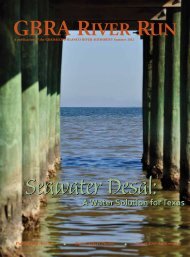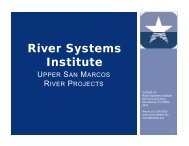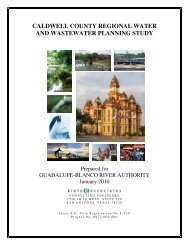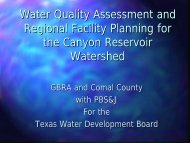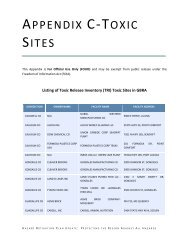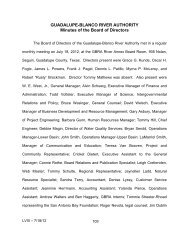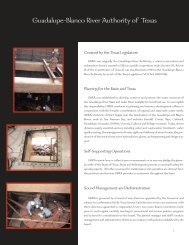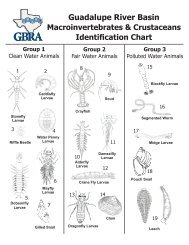Fall 2012 - Guadalupe-Blanco River Authority
Fall 2012 - Guadalupe-Blanco River Authority
Fall 2012 - Guadalupe-Blanco River Authority
You also want an ePaper? Increase the reach of your titles
YUMPU automatically turns print PDFs into web optimized ePapers that Google loves.
latureof epic proportionsto grow into an economic and agricultural force. The increasingpopulation that star status attracts is a problem, however,especially when combined with the 2011 drought, which cost$7.62 billion in agriculture losses alone.“The drought last year—even though we are climbing out ofit—the severity of it has a lot of people’s attention,” CarolynBrittin of the Texas Water Development Board, said recently. “Theeconomic engine of the state is also paying attention.”The TWDB manages the state’s water planning process andoffers financial assistance programs to help fund projects. Brittinis its deputy executive administrator.The economicengine shementionedincludesother statescompeting forindustry bycomparing their plentiful water supplies with Texas’ diminishedreservoirs. “People understand the problem—verification iscoming from other states around the country,” said Rep. DougMiller, R-New Braunfels. The state of Wisconsin, which has wateraplenty, airs advertisements showing its brimming lakes side-bysidewith Texas’ Lake Medina, which is only 13 percent full.“They say, ‘Do you want to go to Texas?’ It’s an economic,competitive factor.”These are the backdrops for the drama that Texas legislators willbe starring in come January.Setting the state legislature’s tableAlthough the issue is as big and diverse as the Lone Star State,water planners on the regional level have offered legislators acourse of action. It is called the <strong>2012</strong> State Water Plan, and itsintroduction is blunt: “In serious drought conditions, Texas doesnot and will not have enough water to meet the needs of itspeople, its businesses, and its agricultural enterprises.” It thenoffers conservation and water management strategies necessary tomeet needs.Taken as a whole, the water plan’s price tag is a steep$53 billion dollars. Although the cost complicates discussions,the TWDB isIn serious drought conditions, Texas does not and willnot have enough water to meet the needs of its people,its businesses, and its agricultural enterprises.making proposalsto the legislaturethat requiresmaller amountsof financing.The TWDB wascreated after the 1954-1956 Texas drought with a mandate to planfor the state’s water supply. In 1997, after another drought, Texaschanged its method of water planning. The legislature created abottom-up process, where 16 state groups make decisions aboutregional water needs. The last three state water plans are productsof this process.However, all planning stops at the plans because the state hasbalked at the expense and because of the philosophy of somelegislators against incurring more debt. Every legislative proposalto finance water projects has failed thus far. For example, a tap feeGBRA <strong>River</strong> Run <strong>Fall</strong> <strong>2012</strong>9





